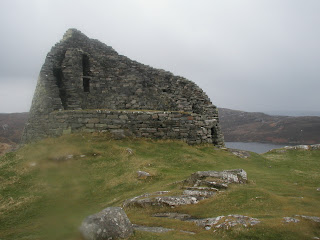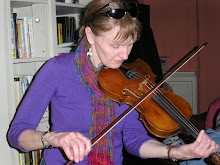






Day 12 Sat April 21
Dun Carloway Broch rises up on hill in the midst of current modern day farms. Perhaps ¼ of the original broch still stands. But the impressive stonework remaining gives a good idea of what life in this multi-storied landowner’s home from the Iron age was like. http://www.stonepages.com/scotland/duncarloway.html
Down the road is the Gearrannan Blackhouse Village. www.gearrannan.com Donald Macarthur was weaving a tweed on a Hattersly loom at the village. All the handweavers in our group marveled at the wonderful hands free, shuttle mechanism sends up to 6 different shuttles flying across the warp.
Most of the 9 houses were built in the 1850’s. In 1989 a trust was formed to restore the houses and the village opened in 2000. When the blackhouses were built, they were long structures with an open plan. Animals lived and one end and people lived at the other. The roof was thatched. Blackhouses were very similar to the much earlier Viking long houses. Most had open fires in the middle of the living area. Medical officers required that dividing walls and windows be put into the houses by the turn of the century. Some also put in chimney’s. 50% of the rurual population on the island still lived in blackhouses up to 1939. Mary, our guide, taught us some Gaelic words and offered us these thoughts. “The people who lived in these houses were penniless. But they had a lot of thing we need here now…community spirit and tolerance. We are losing the richness of simplicity.”
More typical Scottish weather caught up with us today but the Callenish Standing Stones are impressive in sun or rain. The cross formation of stones intersecting this circle sets it apart from stone circles we saw on Orkney. Many other smaller standing stones line the west coast of Lewis.
Harris lies south of Lewis and is known for brilliant sandy beaches and even more rocky landscape than Lewis. From Harris we drove over the 10 year old bridge to the island of Scalpay to visit Sheila Roderick and John Feguson at croft #37. The island has 40 crofts in all. Sheila and John have been farming here for 30 years that. The farm goes back in their family to 1890. To make a living, the industrious couple have 100 lobster creels, 40 Hebridan black sheep, a flock of ducks, guineas, chickens and raise turkeys for the Christmas market. They still harvest their own peat and grow potatoes in lazy beds. Sheila handspins wool for a knitter on Skye. On their Hattersly loom, they weave linen cloth and linsey-woolsey. Some of their fabric ends up in costumes for movies and the theater in London and NY. Success does not come without long hours and hard work but you can hear the love of this rural life in Sheila’s voice. www.scalpaylinen.com
At an unlikey gallery, the upstairs of the An Clachan grocery store in Leverburgh on the southern tip of Harris, is displayed a wonderful labour of love. Gillian Scott-Forrest instigated the Millenium Project. A series of hangings was designed, one for each part of the island. The tweed fabric and the wool yarn used for the pictorial embroidery was hand dyed using plant dyes. Of the 1600 people living on Harris, 90 were involved in the project. The images on each hanging depict both history and current events from each area. Until the project, called the Harris Tapestry, finds a permanent home, you can get your gas, buy your groceries, and learn of the rich history of the people and the island. www.harristapestry.co.uk
Dun Carloway Broch rises up on hill in the midst of current modern day farms. Perhaps ¼ of the original broch still stands. But the impressive stonework remaining gives a good idea of what life in this multi-storied landowner’s home from the Iron age was like. http://www.stonepages.com/scotland/duncarloway.html
Down the road is the Gearrannan Blackhouse Village. www.gearrannan.com Donald Macarthur was weaving a tweed on a Hattersly loom at the village. All the handweavers in our group marveled at the wonderful hands free, shuttle mechanism sends up to 6 different shuttles flying across the warp.
Most of the 9 houses were built in the 1850’s. In 1989 a trust was formed to restore the houses and the village opened in 2000. When the blackhouses were built, they were long structures with an open plan. Animals lived and one end and people lived at the other. The roof was thatched. Blackhouses were very similar to the much earlier Viking long houses. Most had open fires in the middle of the living area. Medical officers required that dividing walls and windows be put into the houses by the turn of the century. Some also put in chimney’s. 50% of the rurual population on the island still lived in blackhouses up to 1939. Mary, our guide, taught us some Gaelic words and offered us these thoughts. “The people who lived in these houses were penniless. But they had a lot of thing we need here now…community spirit and tolerance. We are losing the richness of simplicity.”
More typical Scottish weather caught up with us today but the Callenish Standing Stones are impressive in sun or rain. The cross formation of stones intersecting this circle sets it apart from stone circles we saw on Orkney. Many other smaller standing stones line the west coast of Lewis.
Harris lies south of Lewis and is known for brilliant sandy beaches and even more rocky landscape than Lewis. From Harris we drove over the 10 year old bridge to the island of Scalpay to visit Sheila Roderick and John Feguson at croft #37. The island has 40 crofts in all. Sheila and John have been farming here for 30 years that. The farm goes back in their family to 1890. To make a living, the industrious couple have 100 lobster creels, 40 Hebridan black sheep, a flock of ducks, guineas, chickens and raise turkeys for the Christmas market. They still harvest their own peat and grow potatoes in lazy beds. Sheila handspins wool for a knitter on Skye. On their Hattersly loom, they weave linen cloth and linsey-woolsey. Some of their fabric ends up in costumes for movies and the theater in London and NY. Success does not come without long hours and hard work but you can hear the love of this rural life in Sheila’s voice. www.scalpaylinen.com
At an unlikey gallery, the upstairs of the An Clachan grocery store in Leverburgh on the southern tip of Harris, is displayed a wonderful labour of love. Gillian Scott-Forrest instigated the Millenium Project. A series of hangings was designed, one for each part of the island. The tweed fabric and the wool yarn used for the pictorial embroidery was hand dyed using plant dyes. Of the 1600 people living on Harris, 90 were involved in the project. The images on each hanging depict both history and current events from each area. Until the project, called the Harris Tapestry, finds a permanent home, you can get your gas, buy your groceries, and learn of the rich history of the people and the island. www.harristapestry.co.uk

1 comment:
Thanks for the nice stories and links from your journey. It makes me pack the suitcase and join the group immediately. Looking forward to read the experiences from the last few days. Olinka!
Post a Comment